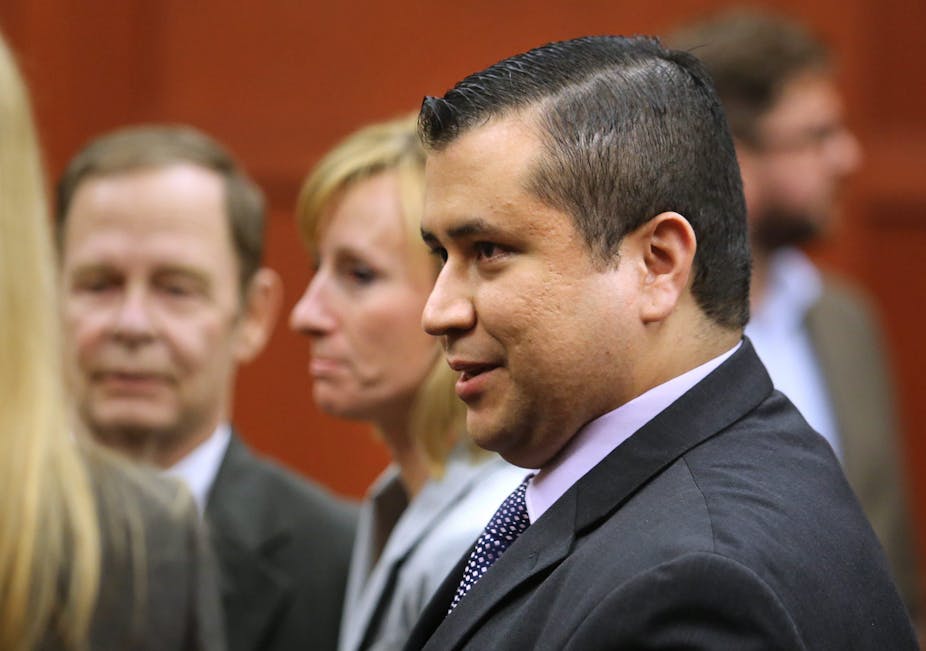The criminal justice system has always been at the sharp end of race relations in the United States. Not only have African Americans been treated more harshly than whites as suspects and offenders, they have been taken less seriously as victims.
From the thousands of lynchings that were never prosecuted to police beatings and murders that triggered riots, African Americans have historically had little reason to believe that the state values their lives as much as those of others. To this day, offenders against black victims are treated more leniently than those whose victims are white.
Against this backdrop the Trayvon Martin case was always going to be about race, regardless of how frequently people claimed it wasn’t. It was about race from the moment George Zimmerman decided, against the instructions of police, to pursue an unarmed black teenager through a Florida gated community because of his supposed resemblance to African American burglars in the area.
When police failed to arrest Zimmerman for shooting Martin dead, accepting his claim that he acted in self-defence, the pattern was all too familiar. The presumption of black criminality meant that a violent black death could be explained away. Despite subsequent concerns that the country had rushed to judge George Zimmerman, the real problem was that police and prosecutors had failed to investigate his story.
By the time protests forced an investigation six weeks later, evidence was hard to find. And by this time, the case was in the grip of an angry backlash against the suggestion that race might have anything to do with it.
Barack Obama, who had barely talked about race at all in the first term of his presidency, noted in a press conference that if he’d had a son, he would “look like Trayvon”. Even this mild expression of solidarity provoked furious accusations that Obama was politicising the case, on which he has since been nearly silent. Support for Zimmerman escalated as gun rights activists began to suspect the case was part of a conspiracy against self-defence. One Tea Party member argued that Zimmerman could have prevented the Sandy Hook massacre had he been there.
Another familiar pattern emerged: the strange but powerful political correctness of anti-anti-racism, to which the Obama White House has been particularly susceptible. From the sacking of Shirley Sherrod to the scolding of black America, Obama as president has upheld an official narrative of “colourblindness”. In colourblind mythology, black anger about racism is itself racist and must be suppressed. The burden lies on blacks to forget the racist past, not on whites to rectify it.
The colourblind narrative dominated the trial of George Zimmerman. The judge forbade any mention of “racial profiling”, forcing the prosecution to describe Zimmerman’s actions as “criminal profiling”. Zimmerman’s lawyers argued that race played no role in Zimmerman’s actions because he had not expressed racial animus towards Martin in police interviews, thus imposing the standard colourblind definition that “racism” can only refer to meetings of the Ku Klux Klan or New Black Panther Party.
Until the prosecution’s closing statement, discussion of race was limited mainly to confected outrage about the use of the term “cracker” by a witness. The same witness attracted merciless derision on social media for her perceived conformity to poor black stereotypes.
There were only two genuine eyewitnesses to the killing of Trayvon Martin. One was dead, and the other was in the dock. Under these circumstances the prosecution could never disprove to a jury that Zimmerman had acted in self-defence, even if his actions had undeniably set off the chain of events that led to the fatal confrontation. As Zimmerman’s lawyer told them:
You can’t fill in the gaps. You can’t connect the dots for the state attorney’s office in this case. You’re not allowed to. This is their burden. They have to take away reasonable doubt.
Zimmerman was acquitted of both second degree murder and manslaughter.
Authorities are justifiably worried about the possibility of civil unrest in the wake of Zimmerman’s acquittal. The failure of the state to punish the killing and wounding of African Americans has long been a potent factor in riots. Even people who feel the jury got the verdict right in legal terms may be aggrieved that, thanks to police and prosecutorial missteps, the stalking and killing of a defenceless black minor has gone completely unpunished.
If there is no unrest, it may be partly due to the efforts of the Community Relations Service of the Department of Justice, which had sent representatives to Sanford, Florida, to ensure protests remained peaceful and to mediate discussions between the community and law enforcement. Their involvement was seized upon by conservative activists as evidence that Obama “took sides once the racial furnace was sufficiently stoked”.
In the lead-up to the verdict, there was actually little to no evidence of racial animus on the part of local African Americans. Unless, as colourblind doctrine sometimes requires, you count demands for justice as dangerous racial provocations.
Once again, the public perception of responsibility for any trouble will fall on black leaders and citizens. More than four years into the Obama presidency, African Americans might wonder whether their rights as citizens will ever include the expectation of equal treatment in the criminal justice system, either as offenders or victims. Obama himself might wonder.

